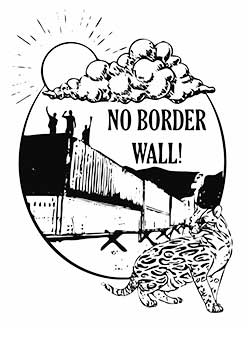The U.S.-Mexico borderlands were once a place of thriving Indigenous lands with diverse populations of migrating plants and animals. Through shifting colonial claims to territory, Mexico switched from Spanish acquisition in the 16th century, and by the mid-19th century, the U.S. had acquired much of Mexico’s northern territory.
Below is a brief timeline of this history.
1845 Texas Annexation admitted the Republic of Texas as the 28th state into the United States. The land had been part of northern Mexico until settlers declared independence following the Texas Revolution (1835-36).
1848 Treaty of Guadalupe Hidalgo, signed at the end of the Mexican American War, ceded considerable Mexican territory (55% of its lands) to the US: Texas, California, Nevada, Utah, New Mexico, most of Arizona and Colorado, and parts of Oklahoma, Kansas, and Wyoming.
1854 Gadsden Purchase / Treaty of Mesilla solidified a land purchase of approximately 30,000 square miles by the US from Mexico. The area included a portion of present-day southern Arizona and southwestern New Mexico.
The history of US efforts to control the border is not just marked by a complex series of laws, treaties, judicial decisions, and executive orders. It also reflects the paths of economic development along with social/cultural attitudes, particularly, racism and prejudice.
1819 Adams-Onis Treaty between US and Spain specified border – lands west of the Mississippi. With Mexican independence from Spain, the 1828 Treaty of Limits reaffirmed the border.
1875 Page Act of 1875 prohibited Chinese women from immigrating to the U.S.
1882 Chinese Exclusion Act marked a significant shift in U.S. immigration policy with the prohibition of in-migration of Chinese laborers. The Act was renewed in 1892 by the Geary Act and made permanent in 1902. Not until 1943, with the Magnuson Act, did the US begin to repeal Chinese exclusion.
1909 The US erected its first border barrier.
1915 The US Congress authorized “mounted inspectors,” charged primarily to pursue Chinese aliens not in compliance with the standing immigration law.
1924 National Origins Act authorized formation of the US Border Patrol.
1986 Immigration Reform and Control Act made it illegal to hire undocumented immigrants and legalized most undocumented immigrants who had entered the U.S. prior to 1982.
1990s Series of regional “Operations” designed to push migrants into remote areas. Move deemed effective for urban centers but caused significant increases of migrant deaths elsewhere. At the same time, there was a shift to prevent through deterrence (more fencing, border patrol agents, technology, lighting, and surveillance).
2003 Established Department of Homeland Security (DHS) in post-911 fervor to prevent terrorists from entering U.S.
2005 Operation Streamline, joint initiative of U.S. Department of Justice and DHS, to prosecute unauthorized border crossing. The Operation has proven to be financially costly and has pushed the handling of immigration offenses into the criminal justice system. It disallows due process for migrants and raises serious judicial concerns regarding legal protections of individuals. (By 2014, the only participants in Operation Streamline were border sectors in Arizona and Texas).
2005 REAL ID Act, authorizing the Secretary of the Department of Homeland Security to waive “all legal requirements” for construction of border barriers and roads.
2006 Secure Fence Act authorized construction of 700 miles of fencing along the border. While Congress initially appropriated $1.4 billion, the estimated total cost was $50 billion.
2017 Executive Order 13767 issued by President D. Trump, directed construction of a US border wall. Construction began in 2018 at an estimated cost of $21.6 billion over 3.5 years.
2021 Executive Order 14010, President J. Biden revoked Executive Order 13767.
Although the border wall has blocked the ease of movement and binational commercial enterprise between Mexico and the USA, it has proven generally ineffective as a barricade against the illegal trafficking of people and illicit substances. However, the physical barrier has been remarkably effective as a statement of power, authority, and insensitivity to Indigenous lands. It creates distinctions between people and makes strong statements of otherness and belonging.
Significantly, the border wall has intruded on the physical landscape of treasured flora and fauna with disastrous consequences. It interferes with natural wildlife migration routes and range expansion, separating animals from food and water, and potential mates. Often the wall interferes with natural drainage, damming washes and even causing severe flooding in border cities accounting for loss of life and property. The border wall harms ecosystems and disrupts the lives and cultures of all border residents (human as well as other living plants and creatures).

